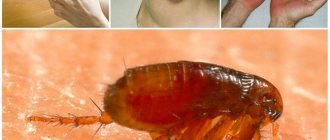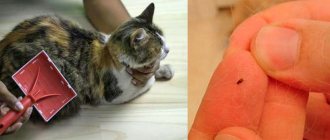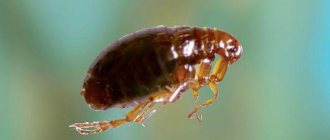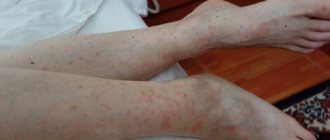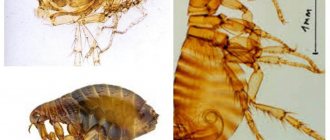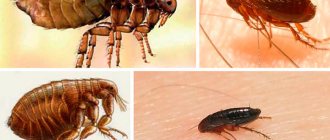Many years have passed since man tamed and domesticated the wild cat. During this time, many new breeds of representatives of the cat family have appeared, so everyone can choose a pet to their liking. Like dogs, cats bring a lot of positive emotions to humans. However, sometimes a lover of cute furry creatures can be upset by fleas that appear on a cat. The cat becomes nervous, constantly itches and scratches its skin. The following questions also raise concerns: How and where can animals become infected with fleas and are fleas transmitted to humans? You will learn the answers to these and many other questions on the topic in this article.
How fleas get on a cat
It is often difficult to understand where a cat's fleas came from? There can be several sources and methods of infection:
- Street. If the cat is outdoor, then the risk of getting fleas increases. They can switch to it from other cats, dogs, mice, rats, or simply from their habitats. Once on the animal’s body, they immediately organize their life activities: they begin to bite it, feed and reproduce.
- Insects getting into your home. A flea on a domestic cat can appear if a person carries the insect home on shoes or clothing. The risk of bringing home “uninvited guests” on your clothes also exists after guests arrive. If there is an animal infested with fleas, then it is possible that a couple of “migrants” will want to visit your apartment.
- Walk. You can also pick up fleas while walking after contact with an infected animal. Therefore, after a walk, it is recommended to carefully examine the animal. Even one flea can cause a lot of trouble not only for a cat, but for people.
- Inheritance. A kitten can get fleas from its mother cat. Therefore, veterinarians advise treating cats' fur before kittens are born.
- Hunting for rodents. If a cat hunts small rodents, it may become a victim of their blood-sucking parasites, since fleas live not only on cats, but also on other animals.
It is quite difficult to immediately determine whether a cat is infected with fleas. The pet behaves as usual, scratching itself occasionally. Only after some time, when the fleas multiply and begin to bite the cat more intensely, can you suspect something is wrong.
Symptoms of flea infestation in a cat:
- restless behavior. The cat itches, tries to rub against pieces of furniture;
- biting yourself. This is how cats try to eliminate fleas on their own;
- deterioration or loss of appetite;
- plaintive meow. The pet tries to contact the person and complain about its condition;
- deterioration of the cat's sleep. Constant bites and itching prevent the cat from sleeping normally.
If you notice some of these symptoms, have your pet examined. By parting the fur, you can see the consequences of infection: there are bites, scratches and bloody wounds on the cat’s body. An infected cat may become very restless, lose weight, and shed a lot. Allergic dermatitis may occur. The animal urgently needs help. In some cases, an animal can even die from an excessive number of fleas. The cause is mainly either infection through bite marks or anemia.
Let's take a closer look at whether cats can pass from cats to humans.
Control of parasites in animals
You can tell if a cat is infested with fleas by several signs:
- the animal often itches and bites itself;
- the cat's skin becomes covered with red spots - traces of bites;
- Black dots appear in the fur - flea excrement.
If there are a lot of insects, they can be easily seen with the naked eye if you part the fur. A kitten picked up on the street can become a real breeding ground for parasites.
If you don't take action, your cat's body will weaken. The animal will become lethargic, its appetite will worsen, and it will have problems sleeping. Due to constant scratching, the bite sites become inflamed, abscesses, fistulas, and allergic dermatitis form.
To prevent fleas from passing from cats to humans, they must be gotten rid of immediately. The most popular method is to bathe your pet with insecticidal shampoo. Modern detergents kill insects from the first use.
There are other ways to get rid of fleas in cats:
- Anti-flea collar – can be impregnated with repellent or insecticide. In the first case, the accessory only repels fleas, so it is better to put it on an already treated cat. Collars with insecticidal substances destroy insects, but in the area of the hind legs and tail their effect is practically not felt. The validity period depends on the composition of the product, usually it is 2-3 months.
- Sprays can both repel and kill fleas. The drug is applied to the entire body of the animal, so there is no chance for insects to sit on the tail or thighs. Disadvantages - the likelihood of intoxication in cats with hypersensitivity, the result lasts only 5-10 days.
- Drops are concentrated solutions with insecticides or repellents. They are applied to the back of the head, which is not accessible when licking. However, the animal runs the risk of poisoning if the owner exceeds the recommended dosage or applies the product to an easily accessible place.
- Tablets are a relatively new development. The active ingredients enter the cat's bloodstream and destroy fleas during a bite. Within a few days, all toxic substances are eliminated from the animal’s body. Cons: additional stress on the liver and kidneys. Such drugs are used only under the supervision of a veterinarian.
Manufacturers produce a whole series of products to combat fleas in cats. Among them you can find all the indicated types of drugs.
Brands that have proven themselves well:
- "Leopard";
- "Ms.Kiss";
- "Beaphar"
- "Doctor Zoo";
- "4 with a tail";
- "Bravecto";
- "Frontline";
- "BlochNet."
Before using any drug, you must carefully read the instructions. Some products cannot be used on kittens, pregnant and lactating cats, weakened and elderly animals.
Important. Fleas develop immunity to insecticides that are constantly used on cats. Therefore, it is not advisable to constantly use the same product.
Are cat fleas transmitted to humans?
In fact, fleas are transmitted from cats to each other, but are not transmitted to humans. But the point is that fleas are transmitted from cats to humans temporarily. They just jump from one victim to another and bite it.
Fleas live much more comfortably on animals. There they are cozy and warm, because there is a lot of wool, and the risk of being noticed is minimal. Human skin does not have such a thick layer of hair, like dogs and cats. In addition, people take showers or baths using a washcloth and soap, so fleas cannot stay there for long. However, biting a person is not particularly difficult for them. They don't fly, but they jump high. Fleas jump to a person from an animal or a place where they may be, for example, on the litter where the cat was sleeping before.
It is not surprising that hungry insects, left without the main source of food, move on to people and bite them. It’s easy to find yourself in a danger zone: fleas can live in an apartment, house, basement, zoo, or in nature. They can also be picked up when working with pets, because fleas from animals jump to humans.
The majority of fleas usually live on fur farms and agricultural enterprises. Blood-sucking insects can also live in old premises, where a lot of unnecessary things, furniture, equipment, etc. have been lying around for a long time. Just one visit to such places, and you can become a victim of a flea, which can jump onto a person from anywhere. This is why these small blood-sucking creatures are still dangerous for humans. Direct contact with the carrier is not necessary.
A cat's resting place is a flea breeding ground
Usually, cat fleas, having fed and satiated with the blood of the animal, leave their usual carrier to lay eggs. For this purpose, a place with high humidity and no access to sunlight is suitable for them. Some species groups of parasites reproduce their own kind directly on the host. Meanwhile, jumping insects, remaining near the egg clutch for some time, can attack a passing “victim”, including a person who does not always feel how they bite him. The flea senses the approach of a potential “breadwinner”, information about which is conveyed to it by air vibration, temperature fluctuations, odors and carbon dioxide emissions.
In general, it should be noted that parasites jumping on a person can not be found very often, for example, in the case when the pet has more than just cat fleas. Having brought home insects dangerous to humans on itself, the cat settles down as usual in its favorite resting place, and at this time human fleas are located nearby, awaiting their long-awaited owner. And so, as soon as a guest approaches the cat’s house, the parasite, sensing the smell of his sweat or breath, attacks.
Treating bites
Usually, if fleas have bitten a person, the discomfort goes away after a few days. But if the pain and itching does not go away within a few days, then the wounds need to be treated. They can be lubricated with a small amount of any anti-inflammatory agent that will relieve burning, itching and redness.
Experts advise people to treat insect bites in the following order:
- Wash the affected skin with water and soap, or treat with an antiseptic.
- Apply ice to the bite site.
- You can eliminate itching from a flea bite with a soda solution or sulfur ointment.
- Treat the bite site with brilliant green, iodine, and ethyl alcohol.
- If allergies occur, it is recommended to take an antihistamine.
Types of fleas that live on pets
Fleas are a group of blood-sucking insects. They are unpretentious and resistant to negative influences, and are found on all continents of the globe, including Antarctica.
More than 200 species of these insects are known. However, in our country only a few are the most common:
- felines;
- canine;
- rabbit;
- rat.
Only an entomologist can see the differences between these species.
Humans most often encounter cat fleas. These insects are able to go without food for a long time. When the temperature drops (down to -20 °C), they fall into suspended animation and can remain in this state for up to a year. At high temperatures (+45...50 °C) adults, larvae and eggs die.
The body length of cat fleas ranges from 1 to 5 mm. They do not have wings, but well-developed hind limbs allow the insects to jump well. Thanks to the notches and scales, they are easily retained in wool, on clothing and other surfaces.
For your information. Cat fleas are capable of jumping up to 30 cm in height and up to 50 cm in length.
These insects have strong jaws. With their help, they gnaw through the host's skin. To prevent the blood from clotting, saliva is injected into the wound. It is this that causes itching and redness at the site of the bite.
Prevention
As you know, it is better to prevent a disease than to treat it. Therefore, pet owners are recommended to occasionally examine their pet for the presence of blood-sucking pests on its fur.
You need to periodically inspect your cat's bedding and the places where it spends most of its time. Be attentive to the animal's behavior.
If a cat is infected with fleas, then you need to immediately start fighting the bloodsuckers in order to completely get rid of them. To eliminate fleas in cats, you can use the following products:
- drops on the withers;
- sprays;
- shampoos for animals;
- anti-flea collars.
After using any of the products, the cat does not need to be washed for three days. Your veterinarian will tell you what to do and which anti-flea remedy to choose, or a specialist at a veterinary pharmacy will advise you.
Fleas are transmitted from cats to humans, from animal to animal, but in addition to treating animal hair, it is also recommended to treat the apartment. Fleas can hide in upholstered furniture, carpets, baseboards, and secluded corners. Getting rid of fleas indoors can be difficult. It is necessary to vacuum the entire room, wash soft toys, clean upholstered furniture, and carry out a complete wet cleaning of the room. Afterwards, the apartment needs to be treated with special anti-parasite compounds. If there are too many fleas, it is recommended to contact an exterminator. This will most likely require temporary relocation of people to another place of residence.
To avoid re-infection of animals, you need to follow preventive measures:
- Treat the animal with anti-flea drugs once a month.
- Regularly clean and inspect your cat's bedding or bed for the presence of fleas.
- Maintaining cleanliness in the apartment.
- Avoid contact between indoor cats and street cats so that the animal cannot become infected with fleas from them. Street cats and their habitats (near entrances, in basements) are the most contagious.
- If fleas are detected, you need to take action to combat the parasites in order to get rid of them without allowing them to reproduce.
Follow simple rules of prevention, and then you will protect your furry pet, yourself and your home.
Insect development cycle
The flea development cycle can take from 10 days to several months. It all depends on environmental conditions. In warm weather, reproduction occurs as quickly as possible; with the onset of cold weather, it slows down or temporarily stops.
Insects develop in 4 stages:
- The adult lays eggs. Most often, they roll off the host animal and spread freely throughout the apartment.
- A worm-like larva about 1 mm long emerges from the egg, capable of moving independently. It usually lives in the cat's bedding and feeds on the feces of adult fleas, dried blood and various organic debris.
- The larva develops, molts three times and pupates, entangling itself in a silk-like cocoon.
- After some time, an adult insect is born.
Eggs are very resistant to adverse factors. They can lie in some secluded corner for months, maintaining their viability. As soon as suitable conditions arise, their development cycle resumes. The most favorable temperatures are considered to be +18…24 °C and air humidity of about 60%.
For your information. The average lifespan of an adult flea is 2-3 months. During this time, she manages to lay 500-800 eggs.
Do they bite?
When wondering whether cat and dog fleas can bite a person, it is worth noting that bloodsuckers do not care what kind of blood they feed on. Insects live on pets, but can also gnaw their owners if there is not enough blood from the animal. This usually happens when there is a small kitten in the house. His body cannot saturate the horde of parasites, then the latter look for food elsewhere.
Interesting fact: cat fleas, unlike dog fleas, bite people more often. After purchasing a pet or before going to an area where pets roam, you should take measures to prevent bites. For animals, these can be collars, gels, sprays, and for humans, special repellent ointments.
How to protect yourself
Animal owners especially often have to deal with the consequences of fleas. But no one can be immune from insects. If fleas decide to live in a house, comprehensive treatment of the home is needed.
It includes:
- freeing pets from insects:
- washing all bedspreads, blankets, curtains, processing upholstery and covers;
- processing the yard and buildings, cutting the grass;
- dismantling and processing of storage rooms and closets.
You will have to shake up the whole house to prevent contamination of secluded places where insects like to live.
To avoid getting infected, you need to avoid going to landfills and the habitats of stray animals, and avoid contact of domestic cats and dogs with them. Anyone who ends up in such places should be inspected and their clothes should be thoroughly shaken out before returning home.
Head disinfection
Fleas of any kind, including human ones, do not live in human hair. To remove individual individuals, it is enough to wash your hair regularly. It is useful to use tar soap or shampoos that are sold in pharmacies against lice and nits.
Treatment of wounds from bites
Special wound treatment is only relevant in cases of infection and severe scratching. In most cases, wounds heal within 1-3 days without any trace.
If there are signs of an allergy, you should consult an allergist, especially if irritation persists after taking antihistamines.
You can lubricate the damage with the following preparations:
- iodine;
- Calamine;
- Fenistil;
- tinctures of chamomile, plantain.
If severe itching occurs, the doctor may prescribe medications with glucocorticosteroids for local (Sinaflan, Hydrocortisone) or oral use.
It is better not to use such means on your own.
Are these insects dangerous for the animal owner or not?
It is very important to know how dangerous fleas are for a pet owner who has become ill with parasites. Common bite marks are not harmless: they can have serious consequences:
- Allergy. Usually occurs in people who are prone to similar reactions and often suffer from various irritants. Allergic dermatitis appears on hypersensitive skin. In this case, the allergen is the flea's saliva, which will cause the bitten area to itch for a long time.
- Infection with worms. Parasites are carriers of nematodes, as well as helminths. As a result, dipilidia may develop, during which tapeworms begin to develop in the body. Their largest size in the intestine is 70 cm.
- Bartonellosis. This is a whole group of diseases that differ from each other, but the source of their occurrence is the same - bacteria carried by fleas. All of them pose a potential danger to humans.
All these diseases can be contracted not only at home if your pet catches fleas. But insects can also bite in the entrance, on the street, when interacting with street animals and even with pets.
Fleas can appear in an apartment very easily: you can bring them on shoes or clothes along with dirt.
It is also worth remembering that fleas are capable of giving rise to entire epidemics, which has already happened more than once: they are carriers of typhoid and plague. Therefore, we must not forget about prevention: check your pet as often as possible for the presence of these unpleasant and dangerous insects.
What do we know about fleas?
The flea is a blood-sucking ectoparasite, characterized by its small size (on average 1-5 mm, but there are larger exceptions) and also its phenomenal jumping ability. The color of the chitinous exoskeleton of this jumper varies from classic brown to deep black.
The habitat of fleas is incredibly large. These small bloodsuckers can be found even in the snows of the Arctic.
Fleas are not picky in choosing a host. They are able to parasitize all warm-blooded creatures, especially cats and dogs due to their thick fur. They are not found only in fish and various amphibian-reptiles.
Since the community of warm-blooded animals is very diverse, including the class of birds, fleas for each species have some differences in appearance. But the fundamental signs are the same for everyone. Based on them, zoologists classified all flea families into one order.
Getting rid of parasites
You cannot live with fleas in the house; you need to get rid of them as soon as the first individual is discovered. General cleaning of the apartment and treatment of animals is required.
Since fleas can live in any place, the main thing is to thoroughly clean all rooms, wash surfaces, and wash things. Bedding and pet houses - change or treat well. Nothing can be excluded; all processing is carried out at one time.
Chemicals
Often only insecticides can completely clean houses of fleas. Let's highlight the best chemicals - ordinary and professional, which will prevent insects from living in the apartment:
- Raptor;
- Pyrethrum – Persian chamomile powder, natural insecticide;
- Combat;
- Biorin, Sinuzan - strong professional products;
- Chlorpirimak is a drug against garden pests;
- Gett;
- Empire 20;
- dust
All of these products require caution when used, but guarantee reliable freedom from all insects.
Folk remedies
Simple folk remedies can relieve itching and irritation. For this use:
- thick soda paste, which is used to lubricate the damage;
- fruit juices – lemon, orange;
- juice of dandelion, marigold, plantain, mint - the leaves must be thoroughly mashed until moisture appears;
- house plants - aloe, kalanchoe - apply leaves or pulp;
- lotions from good tea - not from bags.
These remedies should be used as early as possible.
Professional pest control
If you cannot cope with the flea infestation on your own, you can call special services to clean the area.
They will inform you how to properly prepare for cleansing from parasites and will carry out the necessary measures using insecticides and special equipment for spraying them. They will tell you how to clean the premises after cleaning.
Usually all rooms in the house, the surrounding area and buildings are processed simultaneously. Recommendations are also given for preventing areas where fleas may live.
Cleaning an apartment from fleas
Most often, fleas do not live on a pet, but hide in secluded corners of the apartment. Therefore, after treating the animal, it is necessary to treat the room. First, it is recommended to vacuum the cat's bedding, furniture, carpets, wash soft toys and linens, and do wet cleaning. After this, the room is treated with a composition against such parasites. This can be a concentrate for preparing a solution (Chlorpirimak, Biorin) or a spray (Kombat, Raptor).
You can treat your cat's bedding with insecticides. After all the actions, the room is ventilated and left for 2-3 days.
If this is not possible, you should treat areas where people will be with soapy water. If there are too many fleas, you need to seek help from an exterminator.
Symptoms of aphanipterosis in cats
You can judge whether the fleas of a cat, cat or kitten are dangerous for humans by the frequency of bites and consequences. During the day, bloodsuckers make up to 300 punctures with piercing-sucking proboscis, secreting saliva with hemolytic toxins into the wounds. Inflamed, itchy spots remain on the pet's stomach, back, and inner thighs.
When licking fur, saliva gets on the tongue and allergic reactions develop. They are considered the causes of dermatological diseases. Due to itching to the point of bleeding, cats scratch their skin and locally gnaw out fur. In these places, wet, itchy eczema with brown papules appears that require treatment.
Danger to humans
When understanding the question of whether cat and dog fleas are dangerous for humans, it should be noted that the parasites themselves do not pose a threat to the victim. But if the insect has been in contact with an unhealthy animal and acts as a carrier of the disease, then when bitten, the infection can penetrate into the wound.
Therefore, concluding, doctors say that fleas living on a cat can be dangerous to humans, transmitting to them through the blood:
- Pulicosis.
- Dermatitis.
- Hepatitis.
- Typhus.
- Brucellosis.
- Salmonellosis.
- Encephalitis.
- Helminthiasis.
- Dipilidosis.
- Fever.
- Erythema.
In the Middle Ages, cat fleas caused a plague epidemic, which was dangerous for humans.
Nowadays, fleas rarely cause serious problems when they jump from cats to people. More often, patients suffer from helminthiasis; sometimes, due to intolerance, an individual severe allergic reaction occurs.



